TOYOTA FJ CRUISER 2012 1.G Owners Manual
Manufacturer: TOYOTA, Model Year: 2012, Model line: FJ CRUISER, Model: TOYOTA FJ CRUISER 2012 1.GPages: 540, PDF Size: 10.32 MB
Page 211 of 540

211
2-5. Driving information
2
When driving
If you cannot find any problems, the speed at which trailer swaying occu\
rred
is beyond the limit of your particular vehicle-trailer combination.
Drive at a lower speed to prevent instability. Remember that swaying of the
towing vehicle-trailer increases as speed increases.
CAUTION
■
Trailer towing precautions
To tow a trailer safely, use extreme care and drive the vehicle in accordance
with the trailer’s characteristics and operating conditions. Failure to do so
could cause an accident resulting in death or serious injury. Vehicle stability
and braking performance are affected by trailer stability, brake setting and
performance, and the hitch. Your vehicle will handle differently when towing
a trailer.
■ To avoid accident or injury
●Do not exceed the TWR, unbraked TWR, GCWR, GVWR or GAWR.
● If the gross trailer weight is over 2000 lb. (907 kg), a sway control device
with sufficient capacity is required.
● Adjust the tongue weight within the appropriate range. Place heavier loads
as close to the trailer axle as possible.
● Do not exceed 65 mph (104 km/h), the posted towing speed limit or the
speed limit for your trailer as set forth in your trailer owner’s manual,
whichever is lowest. Slow down sufficiently before making a turn, in cross
winds, on wet or slippery surface, etc. to help avoid an accident. If you
experience a vehicle-trailer instabilit y from reducing a certain speed, slow
down and make sure you keep your vehicle speed under the speed of
which you experience the instability.
● Do not make jerky, abrupt or sharp turns.
● Do not apply the brakes suddenly as you may skid, resulting in jackknifing
and loss of vehicle control. This is especially true on wet or slippery sur-
faces.
● Do not exceed the trailer hitch assembly weight, gross vehicle weight,
gross axle weight and trailer tongue weight capacities.
● Do not use cruise control when towing.
Page 212 of 540
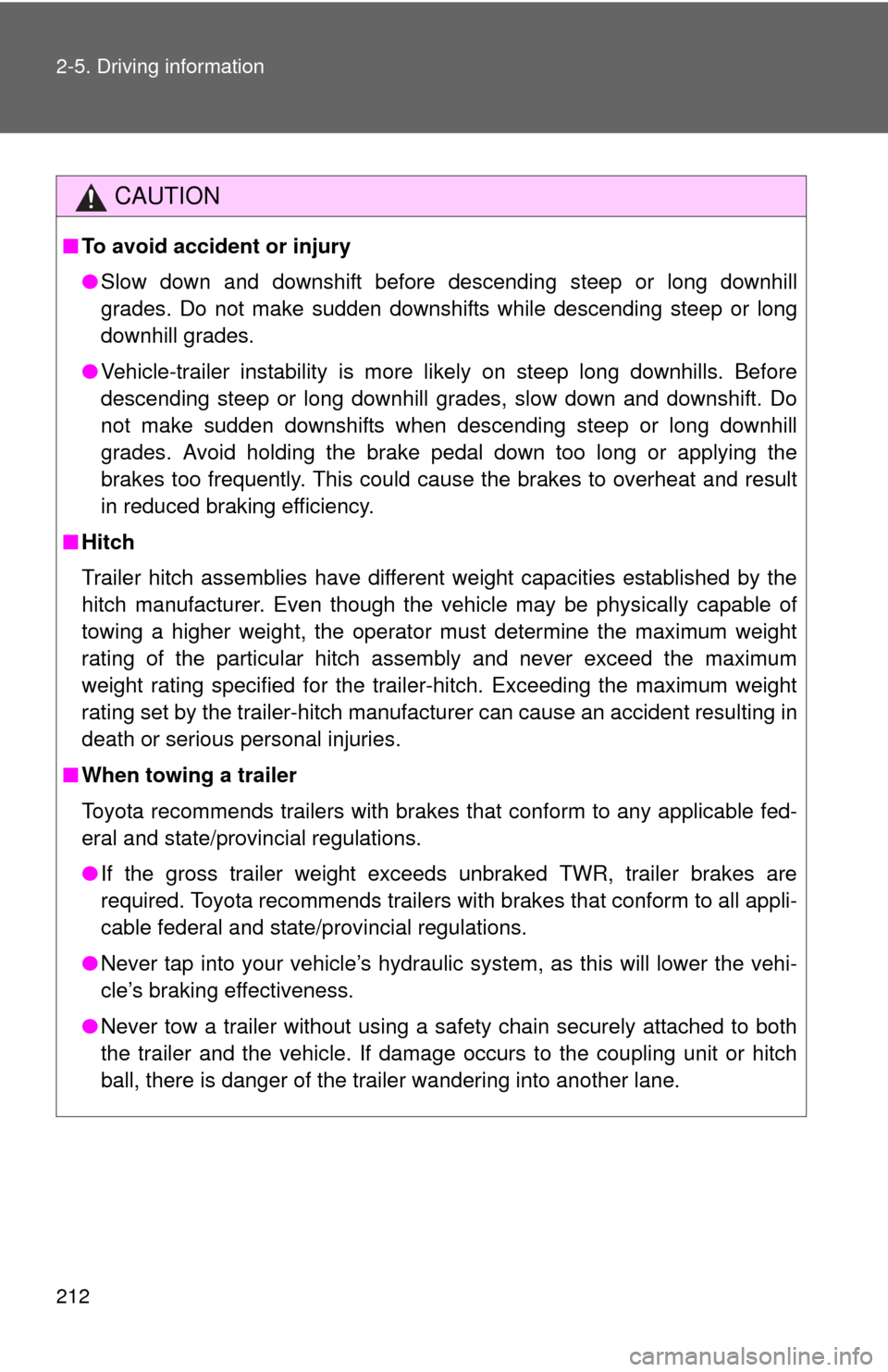
212 2-5. Driving information
CAUTION
■To avoid accident or injury
●Slow down and downshift before descending steep or long downhill
grades. Do not make sudden downshifts while descending steep or long
downhill grades.
● Vehicle-trailer instability is more likely on steep long downhills. Before
descending steep or long downhill grades, slow down and downshift. Do
not make sudden downshifts when descending steep or long downhill
grades. Avoid holding the brake pedal down too long or applying the
brakes too frequently. This could cause the brakes to overheat and result
in reduced braking efficiency.
■ Hitch
Trailer hitch assemblies have different weight capacities established by the
hitch manufacturer. Even though the vehicle may be physically capable of
towing a higher weight, the operator must determine the maximum weight
rating of the particular hitch assembly and never exceed the maximum
weight rating specified for the trailer-hitch. Exceeding the maximum weight
rating set by the trailer-hitch manufacturer can cause an accident resulting in
death or serious personal injuries.
■ When towing a trailer
Toyota recommends trailers with brakes that conform to any applicable fed-
eral and state/provincial regulations.
●If the gross trailer weight exceeds unbraked TWR, trailer brakes are
required. Toyota recommends trailers with brakes that conform to all appli-
cable federal and state/provincial regulations.
● Never tap into your vehicle’s hydraulic system, as this will lower the vehi-
cle’s braking effectiveness.
● Never tow a trailer without using a safety chain securely attached to both
the trailer and the vehicle. If damage occurs to the coupling unit or hitch
ball, there is danger of the trailer wandering into another lane.
Page 213 of 540

213
2-5. Driving information
2
When driving
NOTICE
■
When installing a trailer hitch
Use only the position recommended by your Toyota dealer. Do not install the
trailer hitch on the bumper; this may cause body damage.
■ Do not directly splice trailer lights
Do not directly splice trailer lights. Directly splicing trailer lights may damage
your vehicle’s electrical system and cause a malfunction.
Page 214 of 540
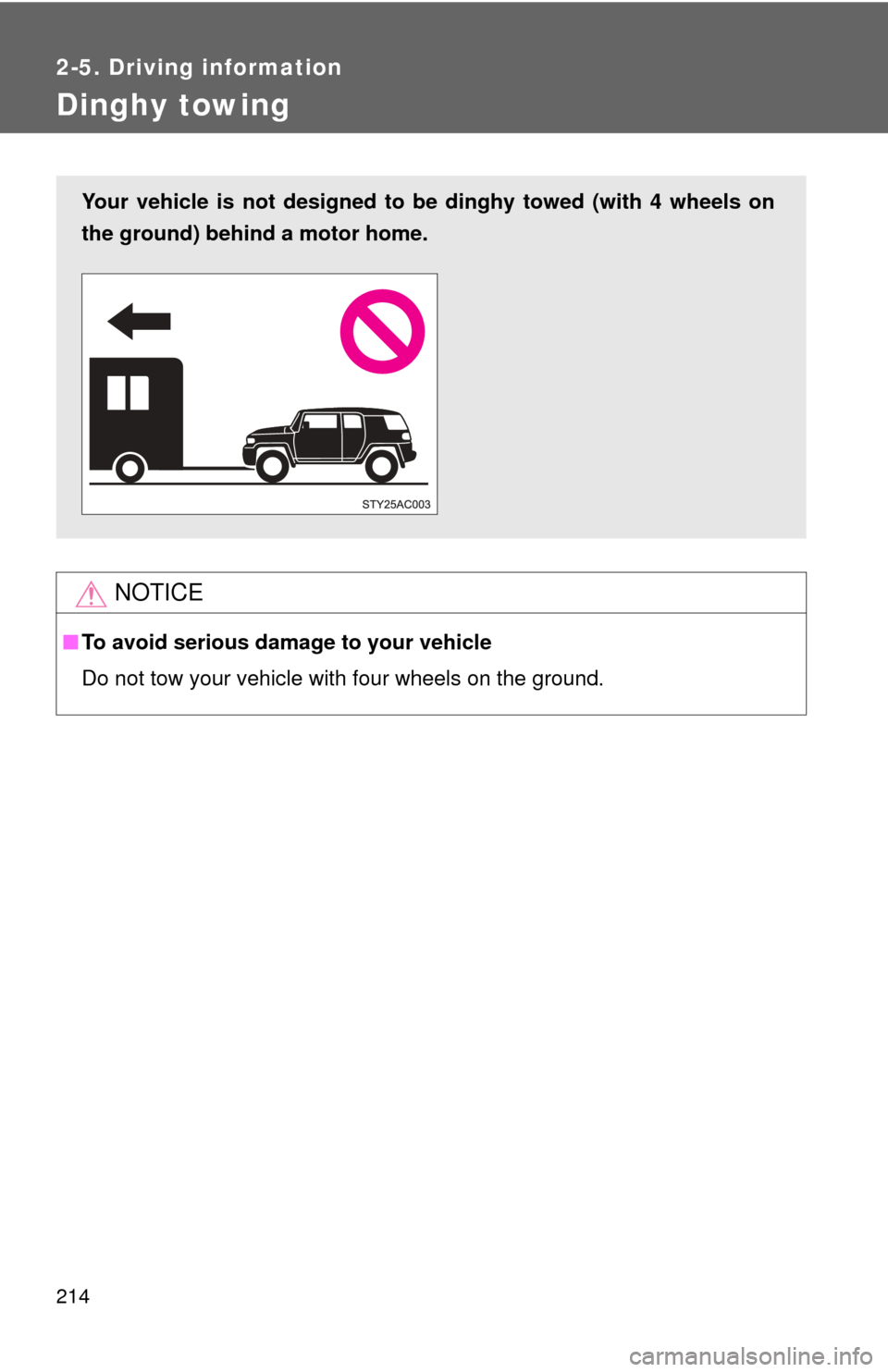
214
2-5. Driving information
Dinghy towing
NOTICE
■To avoid serious damage to your vehicle
Do not tow your vehicle with four wheels on the ground.
Your vehicle is not designed to be dinghy towed (with 4 wheels on
the ground) behind a motor home.
Page 215 of 540

215
2-5. Driving information
2
When driving
Page 216 of 540
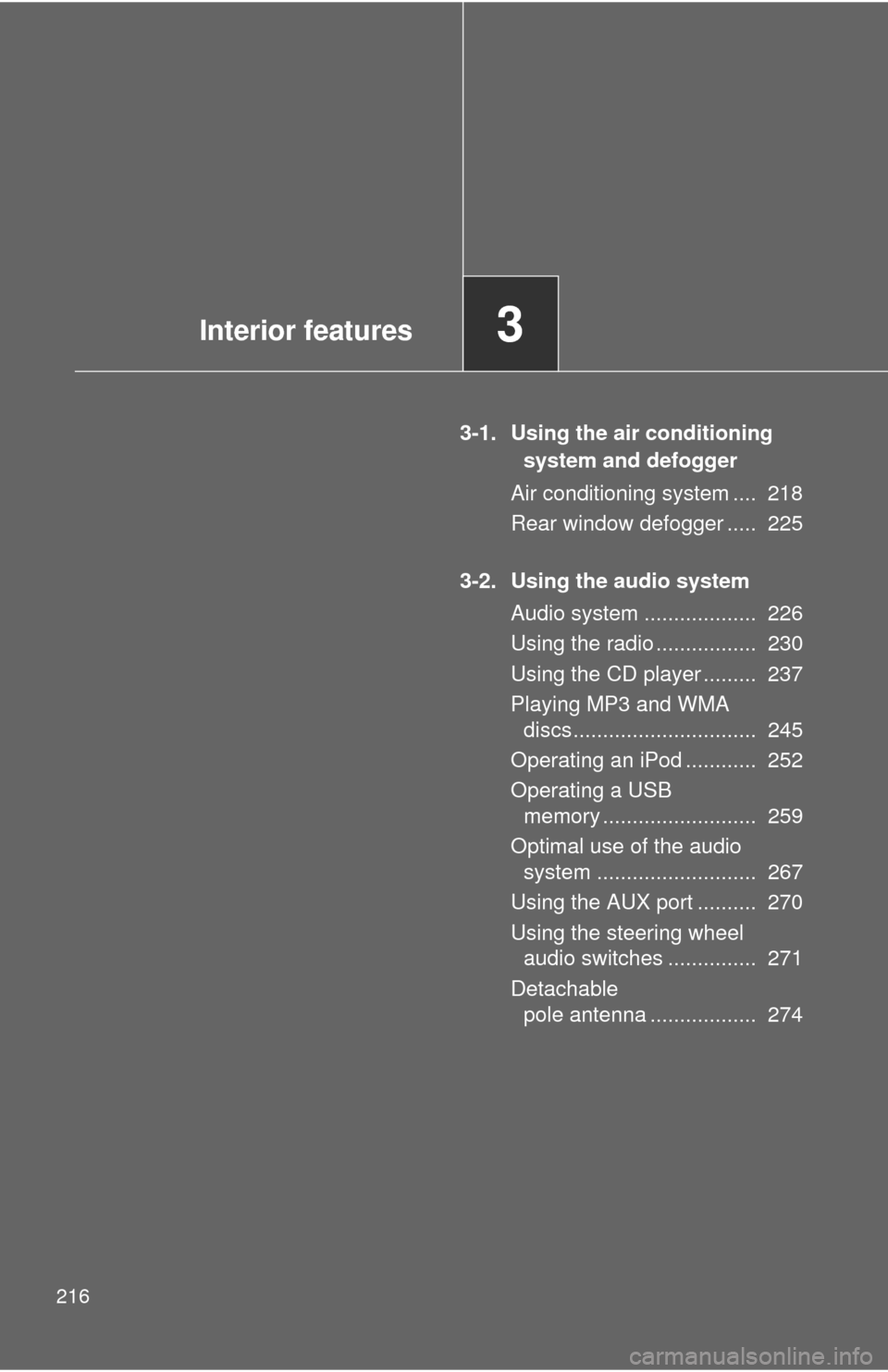
216
3-1. Using the air conditioningsystem and defogger
Air conditioning system .... 218
Rear window defogger ..... 225
3-2. Using the audio system Audio system ................... 226
Using the radio ................. 230
Using the CD player ......... 237
Playing MP3 and WMA discs............................... 245
Operating an iPod ............ 252
Operating a USB memory .......................... 259
Optimal use of the audio system ........................... 267
Using the AUX port .......... 270
Using the steering wheel audio switches ............... 271
Detachable pole antenna .................. 274
Interior features3
Page 217 of 540
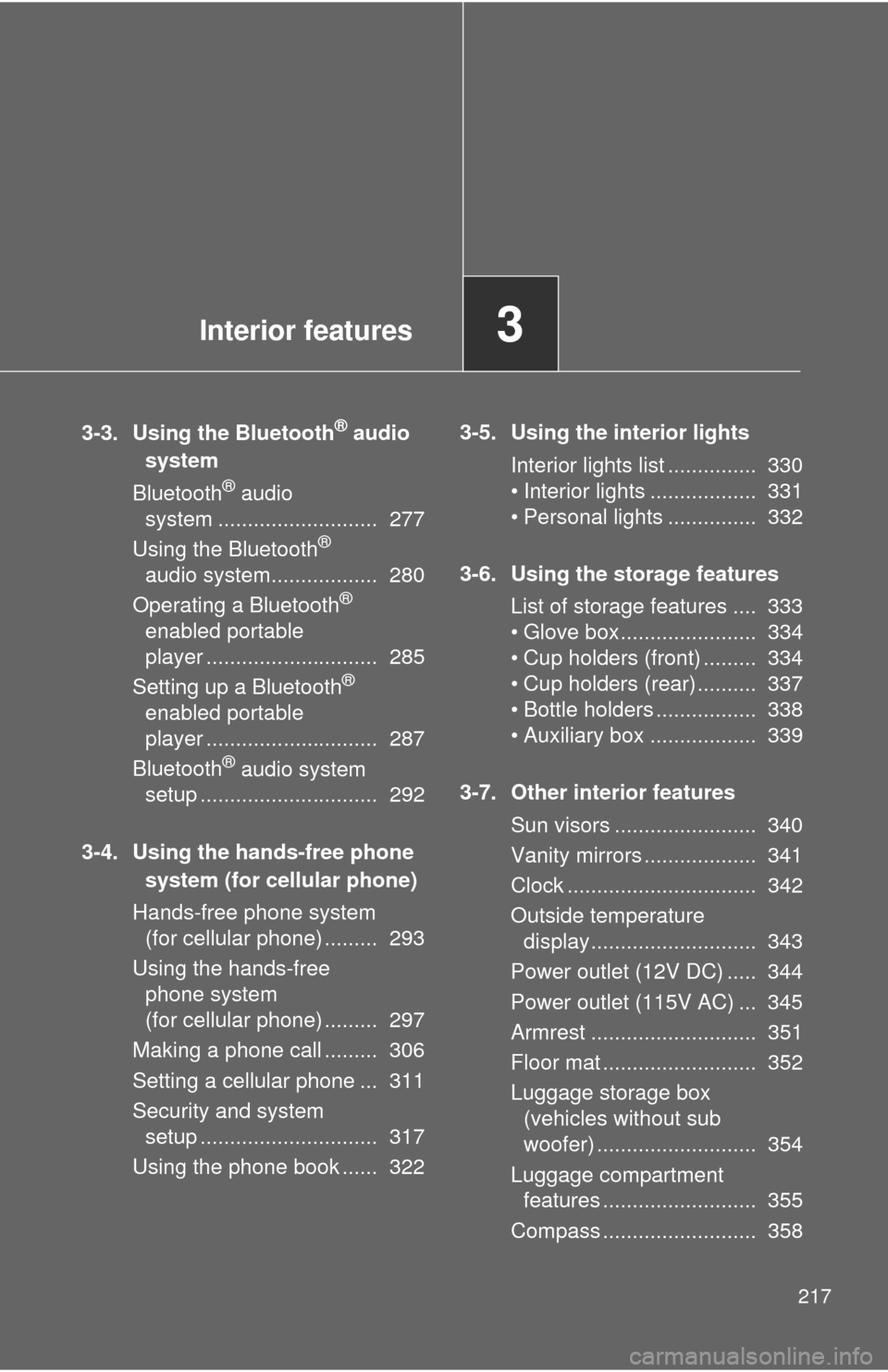
Interior features3
217
3-3. Using the Bluetooth® audio
system
Blu etooth
® audio
system ........................... 277
Using the Bluetooth
®
audio system.................. 280
Operating a Bluetooth
®
enabled portable
player ............................. 285
Setting up a Bluetooth
®
enabled portable
player ............................. 287
Bluetooth
® audio system
setup .............................. 292
3-4. Using the hands -free phone
system (for cellula r phone)
Hands-free phone system (for cellular phone) ......... 293
Using the hands-free phone system
(for cellular phone) ......... 297
Making a phone call ......... 306
Setting a cellular phone ... 311
Security and system setup .............................. 317
Using the phone book ...... 322 3-5. Using the interior lights
Interior lights list ............... 330
• Interior lights .................. 331
• Personal lights ............... 332
3-6. Using the storage features List of storage features .... 333
• Glove box....................... 334
• Cup holders (front) ......... 334
• Cup holders (rear) .......... 337
• Bottle holders ................. 338
• Auxiliary box .................. 339
3-7. Other interior features Sun visors ........................ 340
Vanity mirrors ................... 341
Clock ................................ 342
Outside temperature display............................ 343
Power outlet (12V DC) ..... 344
Power outlet (115V AC) ... 345
Armrest ............................ 351
Floor mat .......................... 352
Luggage storage box (vehicles without sub
woofer) ........................... 354
Luggage compartment features .......................... 355
Compass .......................... 358
Page 218 of 540
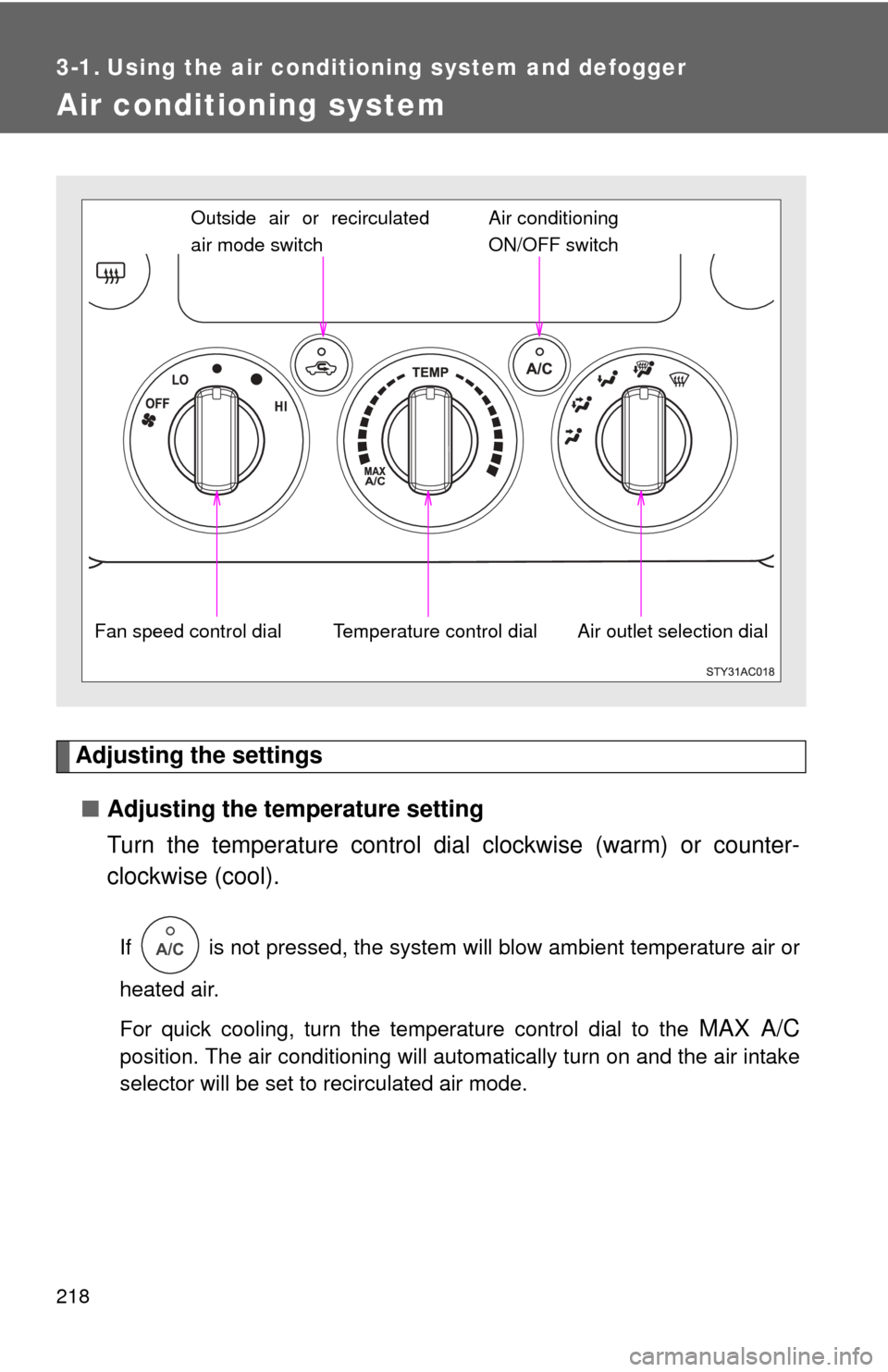
218
3-1. Using the air conditioning system and defogger
Air conditioning system
Adjusting the settings■ Adjusting the temperature setting
Turn the temperature control dial clockwise (warm) or counter-
clockwise (cool).
If is not pressed, the system will blow ambient temperature air or
heated air.
For quick cooling, turn the temperature control dial to the
MAX A/C
position. The air conditioning will automatically turn on and the air intake
selector will be set to recirculated air mode.
Outside air or recirculated
air mode switch
Air outlet selection dialAir conditioning
ON/OFF switch
Temperature control dial
Fan speed control dial
A/C
Page 219 of 540
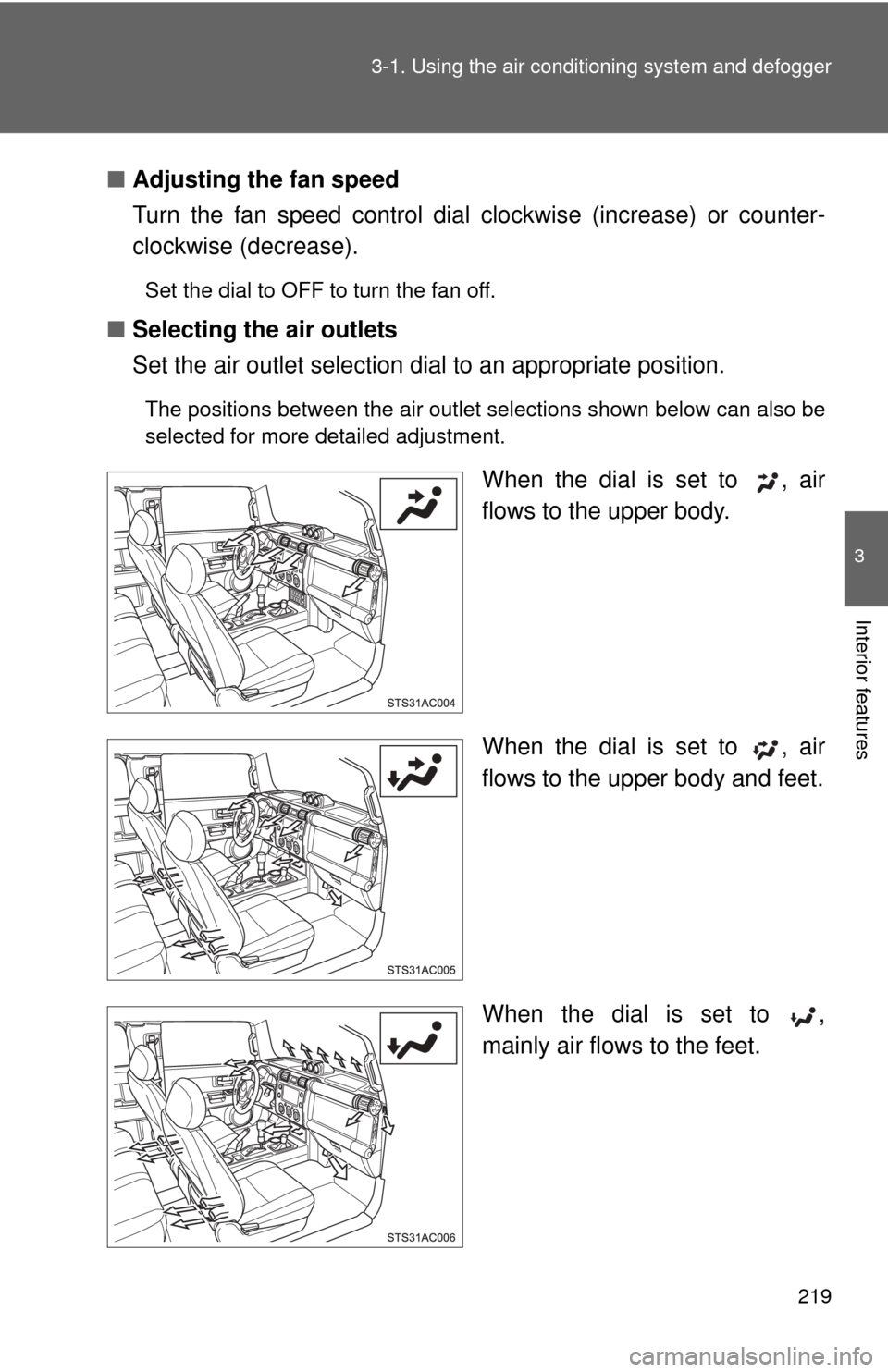
219
3-1. Using the air conditioning system
and defogger
3
Interior features
■Adjusting the fan speed
Turn the fan speed control dial clockwise (increase) or counter-
clockwise (decrease).
Set the dial to OFF to turn the fan off.
■ Selecting the air outlets
Set the air outlet selection di al to an appropriate position.
The positions between the air outlet selections shown below can also be
selected for more detailed adjustment.
When the dial is set to , air
flows to the upper body.
When the dial is set to , air
flows to the upper body and feet.
When the dial is set to ,
mainly air flows to the feet.
Page 220 of 540
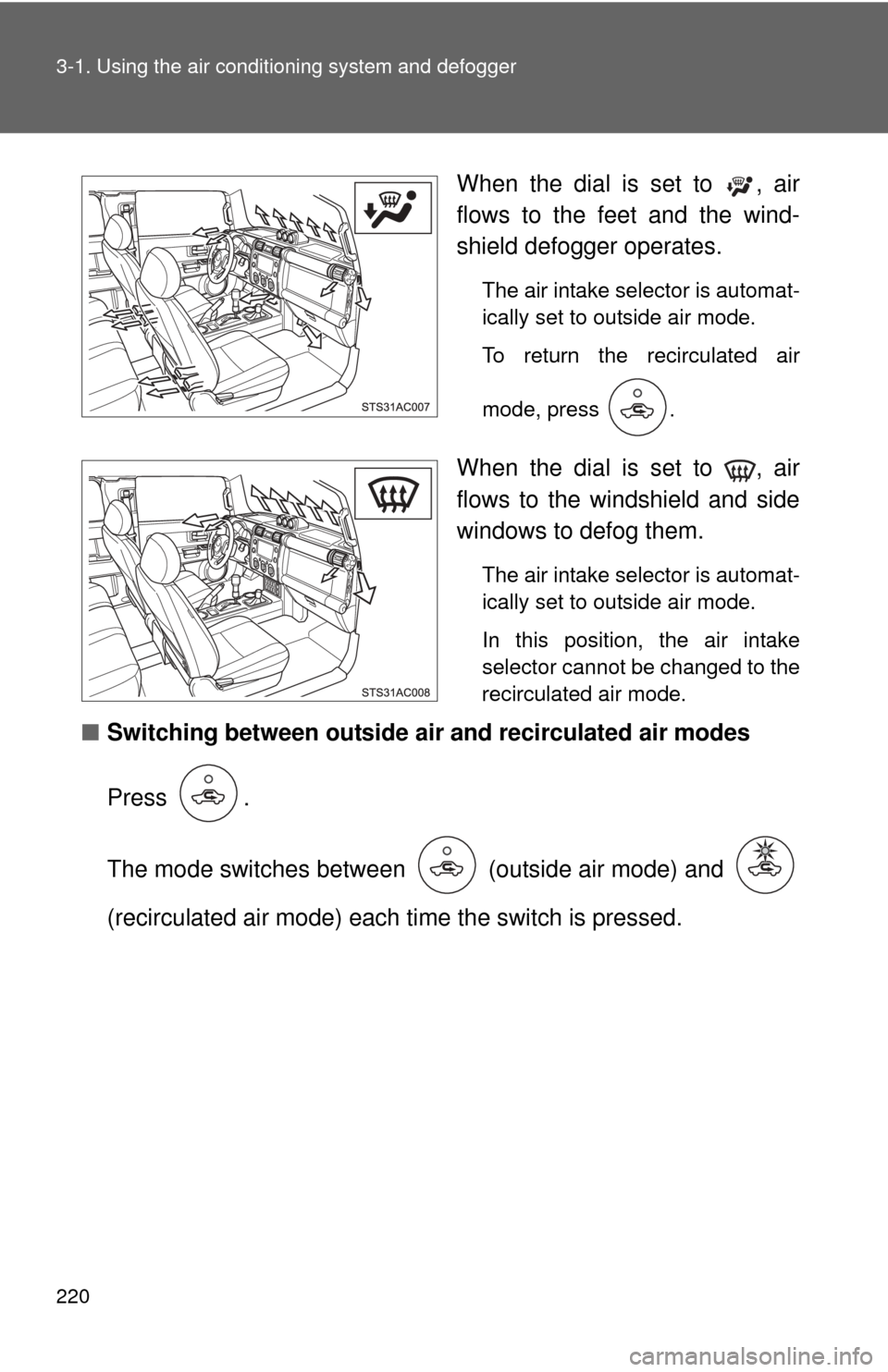
220 3-1. Using the air conditioning system and defogger
When the dial is set to , air
flows to the feet and the wind-
shield defogger operates.
The air intake selector is automat-
ically set to outside air mode.
To return the recirculated air
mode, press
.
When the dial is set to , air
flows to the windshield and side
windows to defog them.
The air intake selector is automat-
ically set to outside air mode.
In this position, the air intake
selector cannot be changed to the
recirculated air mode.
■Switching between outside air and recirculated air modes
Press .
The mode switches between (outside air mode) and
(recirculated air mode) each ti me the switch is pressed.